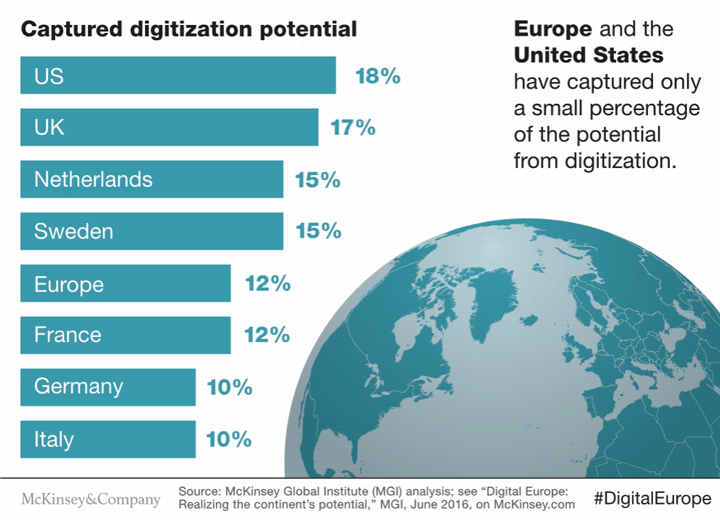Europe is in the midst of a digital transition driven by consumers, thriving technology hubs, and some world-renowned companies. But digitization is also about the extent to which firms and industries invest in and use digital. In these respects, Europe is much less advanced. Yet if its laggards double their digital intensity, Europe can add €2.5 trillion to GDP in 2025, boosting GDP growth by 1 percent a year over the next decade.
What do we mean by digital intensity? It’s the degree to which digitization drives sectors and firms. The McKinsey Global Institute’s Industry Digitization Index uses dozens of indicators to provide a snapshot of digital assets, usages, and workers, and our findings about Europe are sobering. Today, Europe operates at only an estimated 12 percent of its digital potential, compared with the United States’ 18 percent. In addition, there is enormous variation between Europe’s countries: while France operates at 12 percent of its digital potential, Germany is at 10 percent, and the United Kingdom is at 17 percent.
Europe’s low overall level of digital intensity reflects huge gaps between leaders and laggards. The continent’s economy is digitizing unevenly, with large variations among sectors and firms: while the information and communications technology (ICT) sector is at the digital frontier, closely followed by media and finance, large traditional sectors are far behind. Country effects explain one-third of the variation in digital capability across Europe, indicating that countries can influence the extent of digitization within their domestic economy. Sector effects explain the remaining two-thirds of variation in digital intensity across Europe.
Europe underperforms on its digital potential relative to the United States. The European digital frontier, represented by the ICT sector and its digitization of assets, uses, and labor, is only 60 percent as digitized as the US frontier. Some large sectors such as professional services, wholesale trade, and real estate are further behind the digital frontier in Europe than they are in the United States.
Would you like to learn more about the McKinsey Global Institute?
The continent is also a net importer of US digital services, running a digital trade deficit amounting to nearly 5.6 percent of total services trade between the European Union and the United States. Again, there is enormous variation among countries. The United Kingdom and the Netherlands are net exporters of digital services to Europe, while Italy is a net importer. Europe has not matched the United States as a producer of global content and a developer of major platforms, although it has had a measure of success in incubating Internet companies.

Europe’s economy is experiencing the early impact of digitization, with some correlation between productivity growth and digital intensity across sectors. The impact on the labor market is mixed with widespread dislocation of workers but a proliferation of digital tools that offer new ways of working, matching skills, and acquiring skills. In the United States, we find sectors’ digital intensity is correlated with their profit and wage growth. However, these effects are muted in Europe, in part due to the large digital capability gap relative to the digital frontier, both in Europe and the United States.

Digital America: A tale of the haves and have-mores
Europe has key digital strengths that it can exploit for economic gains. The Digital Single Market could accelerate GDP growth, adding €375 billion to €415 billion each year and providing a common platform to allow domestic firms to achieve scale. Even this is dwarfed by the GDP impact if laggard firms and sectors became more digitized.
Business leaders, national and European policy makers, and individuals all have a role to play in accelerating Europe’s digital transition. Companies must assess to what extent digital matters to them and how it might transform their business models. They must also adapt their organizations, digitize their operations, and promote open innovation along the way. Governments should be active on three fronts: unlocking investment and access to capital, opening up data flows, and addressing issues surrounding skills and the labor market. Ultimately, they will have to manage the social and economic transition brought by digitization, including by mitigating its impact on job displacement. Finally, individuals need to develop their skills and embrace the flexibility and new opportunities that digitization offers them.


